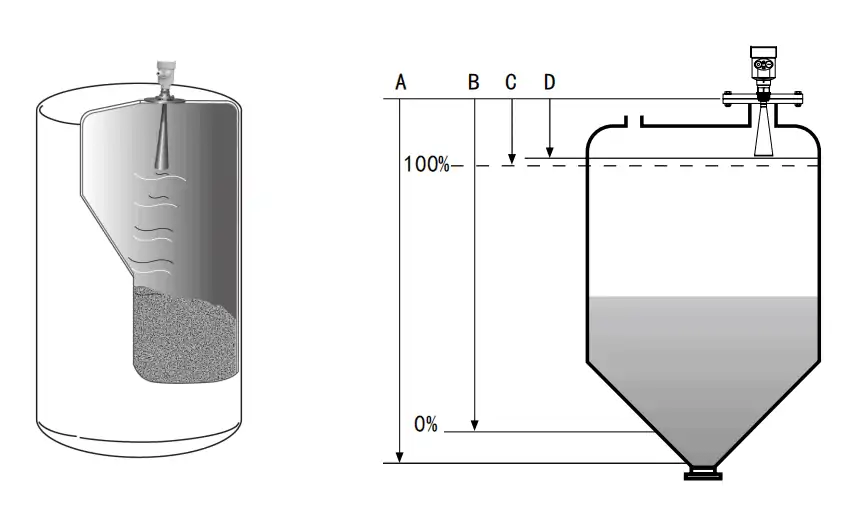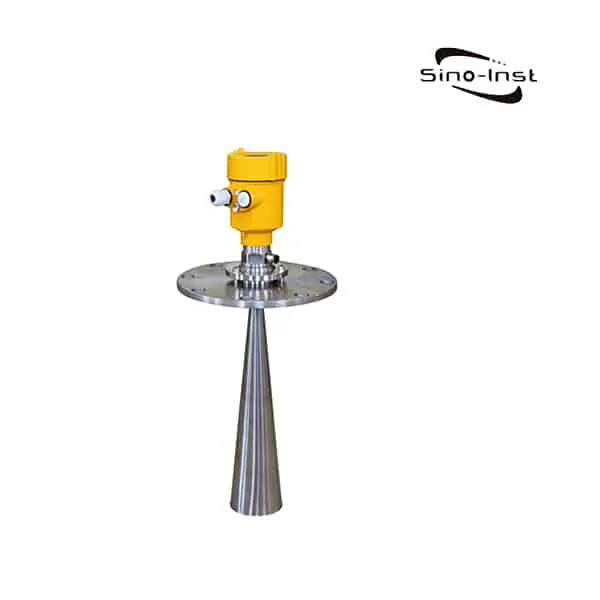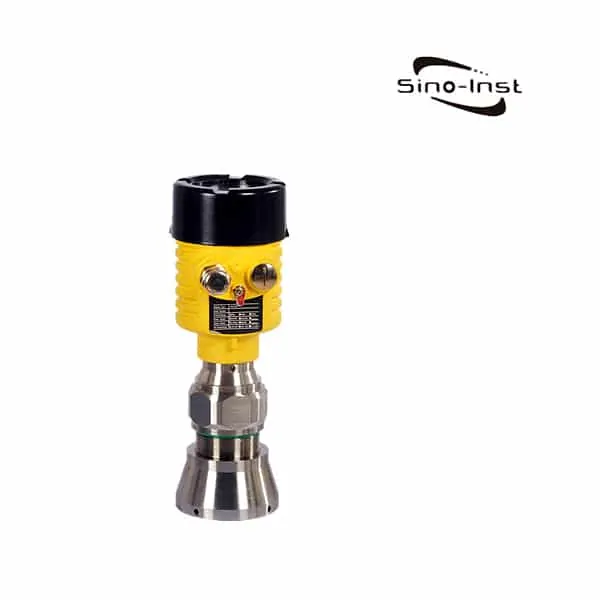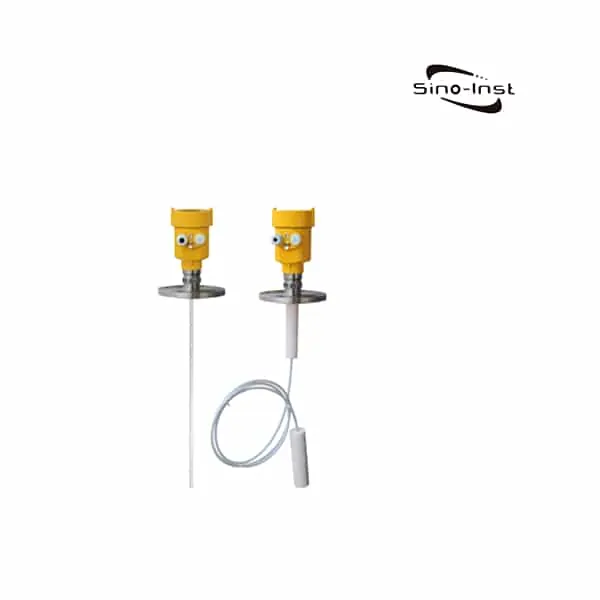
Radar Liquid Level Sensor is an instrument that measures the height of a liquid and converts it into an electrical signal. Using time-domain reflectometry (TDR) sensing technology, Radar Liquid Level Sensor emits and receives high-frequency radio waves (microwaves) to measure the distance to the surface of liquid-based substances. Different from the ultrasonic and guided wave radar transmitter. SIRD-902T Microwave Radar Liquid Level Sensor is a self-heating microwave level sensor. Low-temperature resistance, heat tracing type, non-icing, and anti-crystallization. Suitable for corrosive liquids, steam, and volatile liquids.
Features of SIRD-902T Microwave Radar Liquid Level Sensor

Specifications of SIRD-902T Microwave Radar Liquid Level Sensor
| Application: | Temperature, pressure, slightly corrosive liquid |
| Measuring Range: | 20 meters |
| Process Connection: | Thread, flange |
| Process Temperature: | -40~130℃(standard type) / -40~250℃(high temperature type) |
| Process Pressure: | -0.1~2.0MPa |
| Accuracy: | ±3mm |
| Protection Grade: | IP67 |
| Frequency Range: | 26GHz |
| Supply: | Two-wire system (DC24V) / Four-wire system (DC24V/AC220V) |
| Signal Output: | Exia ⅡC T6 Ga / Exd IIC T6 Gb |
| Outer Covering: | Aluminum Single Chamber / Aluminum Dual Chamber / Plastic / Stainless Steel Single Chamber |
| Explosion-proof Grade: | 4…20mA/HART (two-wire/four-wire) / RS485 Mod bus |
| Antenna Material | Stainless Steel / PTFE |
Radar Level Sensor Application
The measurable conditions of the 902T Radar Liquid Level Sensor are as follows:
- Application: corrosive liquid, steam, volatile liquid
- Measuring range: 20 meters
- Process connection: flange
- Medium temperature: -40~130℃ (standard type)/ -40~230℃ (high temperature type)
- Process pressure: -0.1~2.0MPa
Read more about List of Radar Level Sensors


Radar Liquid Level Sensor Working Principle
The radar-level antenna emits narrow microwave pulses. Downward transmission via the antenna. After the microwave touches the surface of the measured medium, it is reflected back. It is received by the antenna system again and transmitted to the electronic circuit part to automatically convert it into a level signal.

Because microwaves travel so fast, the time it takes for electromagnetic waves to reach the target and return to the receiver by reflection is almost instantaneous.
A range setting
B Low adjustment
C high adjustment
D Blind zone range
The reference plane of the measurement is:
The bottom surface of the thread or the sealing surface of the flange
Note: When using radar level timing, make sure that the highest material level cannot enter the blind area of the measurement (the area shown in D in the figure).
Know more about Level measurement using radar technology
Radar Level Sensor Advantages and Disadvantages
Advantages of radar level measurement
Disadvantages of radar level measurement

Radar Level Sensor for Solids

Measuring medium: liquid and Solids
Measuring range: 0.1m~120m
Process connection: flange≥DN80
Process temperature: -40~200℃; -60~1200℃
Process pressure: -0.1~2.5MPa
Antenna size: 78mm lens antenna
Antenna material: PTFE/full filling

Measuring medium: solid
Measuring range: 0.3m~150m
Process connection: flange≥DN80
Process temperature: -40~110℃
Process pressure: -0.1~0.3MPa
Antenna size: 78mm lens antenna + purging (or without purging)
Antenna material: PTFE

Application: solid materials, strong dust, easy to crystallize, condensation occasions
Measuring range: 70 meters
Process connection: universal flange
Process temperature: -40~130℃ (standard type) / -40~250℃ (high temperature type)
Process pressure: -0.1~4.0 MPa (flat flange) -0.1~0.3 MPa (universal flange)
Accuracy: ±15mm
Protection level: IP67

Application: solid materials, strong dust, easy to crystallize, condensation occasions
Measuring range: 80 meters
Process connection: threaded, universal flange
Process temperature: -40~130℃ (standard type) / -40~250℃ (high temperature type)
Process pressure: -0.1~0.3MPa
Accuracy: ±15mm
Protection level: IP67

Application: solid particles, powder
Measuring range: liquid 35 meters / solid block 20 meters / solid powder 15 meters
Process connection: thread, flange
Process temperature: -40~130℃ (standard type) / -40~250℃ (high temperature type)
Process pressure: -0.1~4.0 MPa (flat flange) -0.1~0.3 MPa (universal flange)
Accuracy: ±15mm
Protection level: IP67

Applicable medium: solid particles or blocks, not suitable for solid powder
Application: Lime block measurement; raw coal measurement
Explosion-proof certification: Exia IIC T6 Ga/ Exd IIC T6 Gb
Measuring range: 35m
Antenna: Horn antenna
Frequency: 6 GHz
Process temperature: -40~130℃(standard type)/-40~250℃(high-temperature type)

Applicable medium: solid, especially medium measurement in a high-temperature environment
Application: Blast furnace level measurement
Explosion-proof certification: Exia IIC T6 Ga/Exd IIC T6 Gb
Measuring range: 15m
Antenna: Horn antenna
Frequency: 6 GHz
Process temperature: (-40~400)℃
Radar Level Sensor Price
The price of the radar level sensor is related to the medium, installation method, and pressure level.
- The medium is divided into ordinary type and anti-corrosion type. The cost of the ordinary type is relatively low, and the price of the anti-corrosion type is relatively expensive.
- The pressure levels are divided into 1.0MPA, 1.6MPA, 2.5MPA, 4.0MPA, 25MPA. The greater the pressure, the more expensive the price. So the pressure is directly proportional to the price.
- Every customer who has bought a radar level sensor knows that the installation method is different. Top-mounted and side-mounted. Because of the different structure, the top-mounted type is more expensive than the side-mounted type.
Sino-Inst provides customers with the most reasonable prices on the basis of ensuring product quality. Radar Level Sensor Price reference range: USD500-1500.00/pc
Extended reading: Solid flow meter | For bulk solids-powder-soybean-cement
Featured Radar Water Level Sensors
Frequently
Asked
Questions
Sino-Inst offers over 10 Microwave Radar Liquid Level Sensors for level measurement. About 50% of these are Radar level meters, 40% is the tank level sensor.
A wide variety of Microwave Radar Liquid Level Sensors options are available to you, such as free samples, paid samples.
Sino-Inst is a globally recognized supplier and manufacturer of radar level measurement instrumentation, located in China.
Request a Quote

Wu Peng, born in 1980, is a highly respected and accomplished male engineer with extensive experience in the field of automation. With over 20 years of industry experience, Wu has made significant contributions to both academia and engineering projects.
Throughout his career, Wu Peng has participated in numerous national and international engineering projects. Some of his most notable projects include the development of an intelligent control system for oil refineries, the design of a cutting-edge distributed control system for petrochemical plants, and the optimization of control algorithms for natural gas pipelines.









